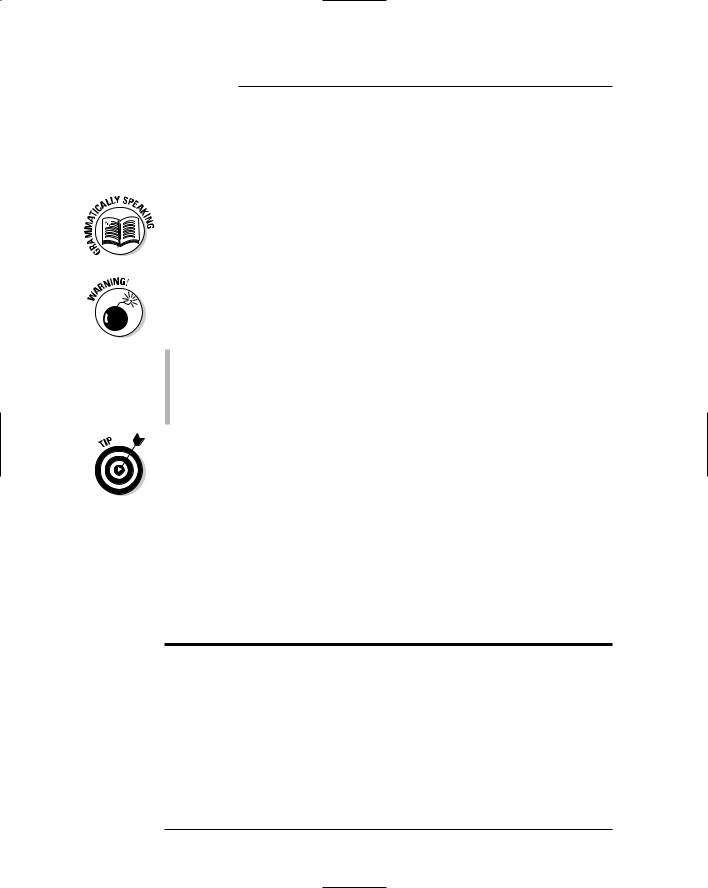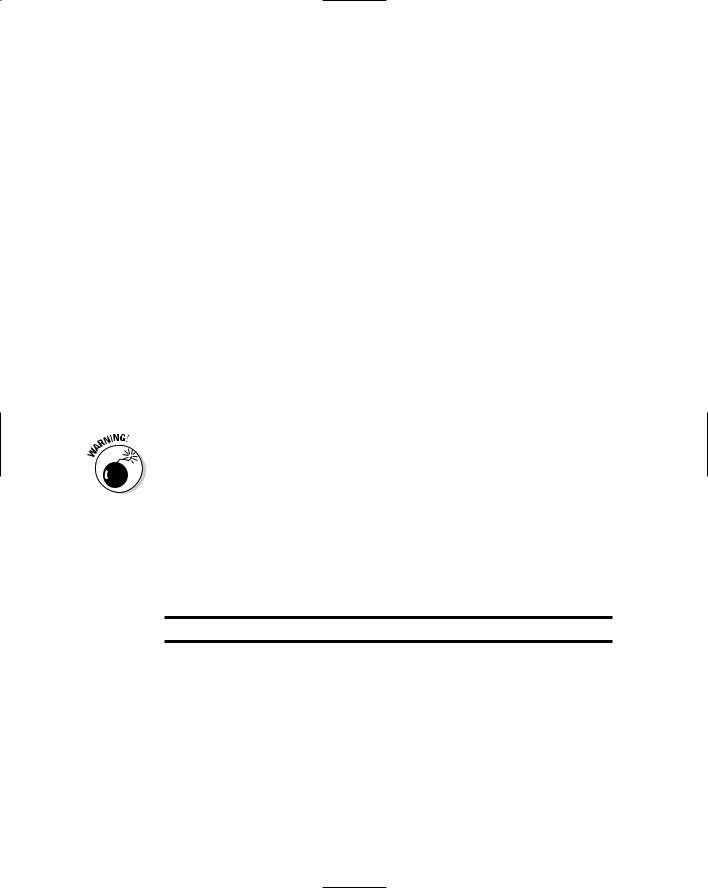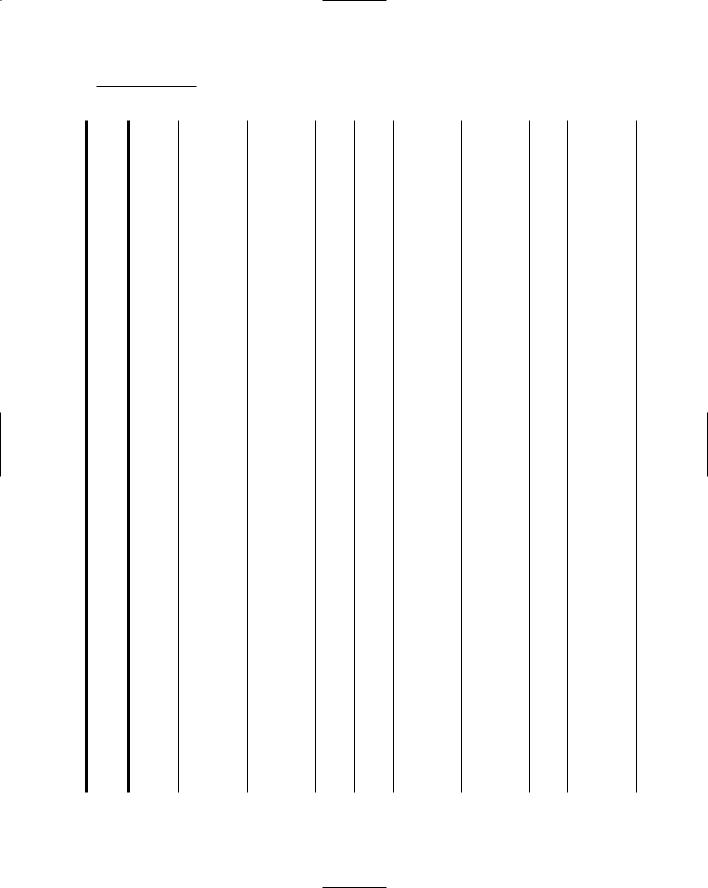
Russian For Dummies
.pdf
34 |
Part I: Getting Started |
Some frequently used verbs, such as pomogat’ (puh-mah-gaht’; to help) and pozvonit’ (puh-zvah-neet’; to call), force the nouns that come after them into the dative case. The implication with these verbs in Russian is that you’re giving help or making a call to somebody, which suggests an indirect receiver of the action of the verb.
Instrumental case
As the name suggests, the instrumental case is often used to indicate the instrument that assists in the carrying out of an action. So, when you say that you’re writing a letter with a ruchka (rooch-kuh; pen), you have to put ruchka into the instrumental case, which is ruchkoj (rooch-kuhy).
Use the instrumental case after certain prepositions such as s (s; with), myezhdu (myezh-doo; between), nad (naht; over), pod (poht; below), and pyeryed (pye-reet; in front of). For more information on prepositions, see Chapter 15.
Prepositional case
Prepositional case got its name because it’s used only after certain prepositions. Older Russian textbooks often refer to it as the locative case, because it often indicates the location where the action takes place. No wonder it’s used with the prepositions v (v; in) and na (nah; on).
The prepositional case is also used after the prepositions o (oh; about) and ob (ohb; about). So when you say to that special someone, “I am constantly thinking about you,” make sure to put ty (tih; you; informal singular) in the prepositional case, which is tyebye (tee-bye): Ya postoyanno dumayu o tyebye (yah puhs-tah-ya-nuh doo-muh-yu uh tee-bye).
By the way, you may wonder why the English preposition “about” is translated by two different Russian equivalents: o and ob. For your information, o is used if the following word begins with a consonant. Use ob if the following word begins with a vowel.
Building Your Grammar Base with Nouns and Pronouns
Nouns and pronouns are the building blocks of any sentence. In the following sections, you find out about the three different genders for nouns. You also

Chapter 2: The Nitty Gritty: Basic Russian Grammar and Numbers |
35 |
discover how to change the ending of nouns and pronouns depending on their function in a sentence and how to form plurals of nouns.
Getting the lowdown on the gender of nouns
A noun can be a person, an animal, a place, a thing, an event (Easter, funeral), an idea (truth, virtue), or even a feeling (envy, love). Unlike English nouns, every Russian noun has what’s called a grammatical gender: either masculine, feminine, or neuter. All nouns have gender, and not just humans or living beings.
Knowing the grammatical gender of a noun is important, because gender determines how the noun changes for each of the six cases.
In the following sections, we explain how to determine the gender of nouns in Russian and warn you about some tricky-looking nouns.
Which one is it? How to tell the gender of a Russian noun
Determining the gender of a Russian noun is simple and a lot of fun. To truly enjoy determining the gender of a noun, you need to know that it’s the ending of a noun that in most cases indicates the noun’s gender. In their dictionary form (the nominative case), Russian nouns may end with only one of the following: a consonant; -j (an unusual letter — see Chapter 1); the vowels -a, -ya, -o, -ye, and -yo; or the soft sign (’).
To define the gender of a noun, just follow the rules in Table 2-1.
Table 2-1 Determining the Gender of a Russian Noun
If a Noun in Nominative |
The Noun’s Gender Is |
Case Ends In |
|
A consonant |
Masculine |
|
|
-j |
Masculine |
|
|
-a or -ya |
Feminine |
|
|
-o, -ye, or -yo |
Neuter |
|
|
Soft sign (‘) |
Either feminine or masculine; look up |
|
this word in the dictionary to be sure |
|
|

36 |
Part I: Getting Started |
Grammatical gender for words denoting living beings, in the majority of cases, coincides with biological gender. The word mal’chik (mahl’-cheek; boy) is a masculine noun and the word dyevushka (dyeh-voosh-kuh; girl) is a feminine noun, just as you’d expect.
When it comes to inanimate objects, grammatical gender seems to have no relationship to the meaning of the word. The word dvyer’ (dvyer’; door) is feminine, while pol (pohl; floor) is masculine noun. Okno (ahk-noh; window) is neuter, while zanavyeska (zuh-nuh–vyes-kuh; curtain) is feminine.
Gender deviants: Masculine nouns that look feminine
A number of common Russian nouns denoting male beings can be confusing, because their grammatical gender is actually feminine. These nouns are considered feminine, because they have the feminine ending -a:
muzhchina (moo-sh’ee-nuh; man)
papa (pah-puh; dad)
dyedushka (dye-doosh-kuh; grandfather)
dyadya (dya-dye; uncle)
These gender deviants behave just like feminine nouns when their endings change for each of the cases. Memorizing them is a good idea, because they’re words you use a lot.
Checking out cases for nouns
Noun declension is when you change the case endings for nouns. Table 2-2 shows you the declension for masculine, feminine, and neuter singular nouns for all the cases. This table shows declension for singular nouns only. For plural noun declension, see the next section.
Table 2-2 |
|
Declension of Singular Nouns |
|
||
If a Noun In Its |
To Form |
To Form |
To Form |
To Form |
To Form |
Dictionary Form Genitive |
Accusative |
Dative |
Instrumental |
Prepositional |
|
(Nominative |
|
|
|
|
|
Case) Ends In |
|
|
|
|
|
A consonant |
Add -a |
Add -a if the |
Add -u |
Add -om |
Add -ye |
|
|
noun is a |
|
|
|
living being; otherwise, don’t do anything

|
|
Chapter 2: The Nitty Gritty: Basic Russian Grammar and Numbers |
37 |
||||||
|
|
||||||||
|
|
|
|
|
|
|
|
|
|
|
If a Noun In Its |
To Form |
To Form |
To Form |
To Form |
To Form |
|
||
|
Dictionary Form Genitive |
Accusative |
Dative |
Instrumental |
Prepositional |
|
|||
|
(Nominative |
|
|
|
|
|
|
|
|
|
Case) Ends In |
|
|
|
|
|
|
|
|
|
-a |
Replace |
Replace |
Replace - |
Replace |
Replace -a |
|
||
|
|
|
-a with -y |
-a with -u |
a with -ye |
-a with -oj |
with -ye |
|
|
|
|
|
|
|
|
|
|
|
|
|
-iye |
Replace |
Don’t do |
Replace |
Replace |
Replace -iye |
|
||
|
|
|
-iye with |
anything |
-iye with |
-iye with |
with -ii |
|
|
|
|
|
-iya |
|
-iyu |
-iyem |
|
|
|
|
|
|
|
|
|
|
|
|
|
|
-iya |
Replace |
Replace |
Replace |
Replace |
Replace |
|
||
|
|
|
-iya with |
-iya with |
-iya with |
-iya with |
-iya with -ii |
|
|
|
|
|
-ii |
-iyu |
-ii |
-iyej |
|
|
|
|
-j |
Replace |
Replace -j |
Replace -j |
Replace -j |
Replace -j |
|
||
|
|
|
-j with -ya |
with -ya if |
with -yu |
with -yem |
with -ye |
|
|
|
|
|
|
the noun is a |
|
|
|
|
|
|
|
|
|
living being; |
|
|
|
|
|
|
|
|
|
otherwise, |
|
|
|
|
|
|
|
|
|
don’t do |
|
|
|
|
|
|
|
|
|
anything |
|
|
|
|
|
|
-o |
Replace |
Don’t do |
Replace |
Replace |
Replace -o |
|
||
|
|
|
-o with -a |
anything |
-o with |
-o with |
with -ye |
|
|
|
|
|
|
|
-u |
-om |
|
|
|
|
|
|
|
|
|
|
|
|
|
|
-ye |
Replace |
Don’t do |
Replace |
Replace |
Don’t do |
|
||
|
|
|
-e with |
anything |
-ye with |
-ye with |
anything |
|
|
|
|
|
-ya |
|
-yu |
-yem |
|
|
|
|
|
|
|
|
|
|
|
|
|
|
-ya |
Replace |
Replace |
Replace |
Replace |
Replace -ya |
|
||
|
|
|
-ya with -i |
-ya with |
-ya with |
-ya with |
with -ye |
|
|
|
|
|
|
-yu |
-ye |
-yej |
|
|
|
|
Soft sign (‘) |
If the noun |
If the noun |
If the noun |
If the noun is |
If the noun is |
|
||
|
|
|
is feminine, is feminine, |
is feminine, |
feminine, |
feminine, |
|
||
|
|
|
replace |
don’t do |
replace |
replace the |
replace the |
|
|
|
|
|
the soft |
anything |
the soft |
soft sign |
soft sign with |
|
|
|
|
|
sign with -i |
If the noun is sign with |
with -yu |
-i |
|
||
|
|
|
If the |
masculine |
-i |
If the noun is |
If the noun is |
|
|
|
|
|
noun is |
and a living |
If the noun |
masculine, |
masculine, |
|
|
|
|
|
masculine, |
being, |
is |
replace the |
replace the |
|
|
|
|
|
replace |
replace the |
masculine, |
soft sign with soft sign with |
|
||
|
|
|
the soft |
soft sign |
replace |
-yem |
-ye |
|
|
|
|
|
sign with |
with -ya; |
the soft |
|
|
|
|
|
|
|
-ya |
otherwise, |
sign with |
|
|
|
|
|
|
|
|
don’t do |
-yu |
|
|
|
|
|
|
|
|
anything |
|
|
|
|
|
|
|
|
|
|
|
|
|
|
|

38 |
Part I: Getting Started |
Russian nouns in the nominative case never end in the letters -i, -u, -y, -e, or -yu. A small number of nouns end in -yo, but they’re special cases and we deal with them as they come up.
This table may look kind of scary at first, but it’s actually easy to use. Imagine you want to brag to your Russian friends about your new car by saying “I bought my friend a car.” The first part of the sentence is ya kupil (ya koo- peel; I bought). But what should you do with the nouns “car” and “friend”?
In this sentence, mashina (muh-shih-nuh; car) is a direct object of the action expressed by the verb kupil (koo-peel; bought). That means you have to put mashina into the accusative case. (For more info on cases, see “Making the Russian Cases” earlier in this chapter.)
The next step is to find the appropriate ending in Table 2-2. You find this ending in the second row, third column. The table says to replace -a with -u.
Now what about drug (drook; friend)? Because “friend” is the indirect object of the sentence (the person to whom or for whom the action of the verb is directed), it takes the dative case in Russian. Table 2-2 indicates that if a noun ends in a consonant (as does drug), you form the dative case by adding the letter -u to the final consonant. The correct form for drug in this sentence is drugu (droog-oo). So here’s your complete sentence: Ya kupil drugu mashinu (yah koo-peel droog-oo muh-shih-noo; I bought my friend a car).
Congratulations! You just created your first Russian sentence!
Putting plurals into their cases
As you probably guessed, Russian plural nouns take different endings depending on the case they’re in. In the following sections, you find out about all the different rules for forming the plural. We start with the nominative plural and then look at plural declension for all the other cases.
Forming plurals in the nominative case
Table 2-3 shows you the rules for plural formation in the nominative case.
Table 2-3 Forming the Plural of Nouns in the Nominative Case
If a Noun In Its Dictionary Form |
To Form the Nominative |
(Nominative Case) Ends In |
Plural |
A consonant |
Add -y |
|
|
-a |
Replace -a with -y |
|
|
-iye |
Replace -iye with -iya |
|
|

|
|
Chapter 2: The Nitty Gritty: Basic Russian Grammar and Numbers |
39 |
||
|
|
||||
|
|
|
|
|
|
|
If a Noun In Its Dictionary Form |
To Form the Nominative |
|
||
|
(Nominative Case) Ends In |
Plural |
|
|
|
|
-iya |
Replace -iya with -ii |
|
||
|
|
|
|
|
|
|
-j |
Replace -j with -i |
|
||
|
|
|
|
|
|
|
-o |
Replace -o with -a |
|
||
|
|
|
|
|
|
|
-ye |
Replace -ye with -ya |
|
||
|
|
|
|
|
|
|
-ya |
Replace -ya with -i |
|
||
|
|
|
|
|
|
|
Soft sign (‘) |
Replace soft sign with -i |
|
||
|
|
|
|
|
|
Practice using this table. Take the word komp’yutyer (kahm-p’yu-tehr; computer). If you want to say “computers” in Russian, first ask yourself what the word komp’yutyer ends in: the consonant r. When you look at the first row and first column of Table 2-3, you see that if a noun ends in a consonant, to form the plural you need to add the letter y at the end. So “computers” in Russian is komp’yutyery (kahm-p’yu-teh-rih).
The rules in Table 2-3 have a few important exceptions. Some consonants, namely zh, sh, sh’, g, k, and kh, are very touchy. They just don’t tolerate the letter y after them and prefer an i instead. Take, for example, the word kniga (knee-guh; book). According to Table 2-3, kniga should replace the final -a with -y to form its plural. But the touchy g doesn’t tolerate the -y ending. It takes an -i ending instead. So the plural of kniga is knigi (knee-gee; books).
Changing plurals into the genitive case
Forming the plurals of nouns in the genitive case is a little trickier than in the other cases, so we deal with it first in Table 2-4.
Table 2-4 Forming the Plural of Nouns in the Genitive Case
If a Noun In Its Dictionary Form |
To Form Genitive Plural |
(Nominative Case) Ends In |
|
A consonant other than -zh, -sh, -sh’, |
Add -ov: studyent (stoo-dyent; male |
-ch, or -ts |
student) becomes studyentov |
|
(stoo-dyen-tuhf; male students) |
|
|
-zh, -sh, -sh’, -ch, or soft sign |
Add -yej: klyuch (klyuch; key) |
|
becomes klyuchyej (klu-chyey; keys) |
-ts |
Add -yev: myesyats (mye-seets; |
|
month) becomes myesyatsyev (mye- |
|
see-tsehf; months) |
|
|
(continued)

40 |
Part I: Getting Started |
|
|
|
|
|
|||
|
|
|
|
|
|
|
Table 2-4 (continued) |
|
|
|
|
If a Noun In Its Dictionary Form |
To Form Genitive Plural |
|
|
|
(Nominative Case) Ends In |
|
|
|
|
-a |
Drop the final –a |
|
|
|
|
|
If the resulting genitive plural form |
|
|
|
|
has two consonants at the end, the |
|
|
|
|
fill vowel -o or -e is often added |
|
|
|
|
between the consonants: sosyedka |
|
|
|
|
(sah-syed-kuh; female neighbor) |
|
|
|
|
becomes sosyedok (sah-sye-duhk; |
|
|
|
|
female neighbors) |
|
|
-iye or -iya |
Replace -iye or -iya with -ij: stantsiya |
|
|
|
|
|
(stahn-tsih-ye; station) becomes |
|
|
|
|
stantsij (stahn-tsihy; stations) |
|
|
|
|
|
|
|
-j |
Replace the final -j with -yov if the |
|
|
|
|
|
ending is stressed, or with -yev if the |
|
|
|
|
ending is not stressed: popugaj (puh- |
|
|
|
|
poo-gahy; parrot) becomes popu- |
|
|
|
|
gayev (puh-poo-gah-eef; parrots) |
|
|
-o |
Drop the -o: myesto (myes-tuh; place) |
|
|
|
|
|
becomes myest (myest; places) |
|
|
|
|
|
|
|
-ye |
Add -j: morye (moh-ree; sea) |
|
|
|
|
|
becomes moryej (mah-ryey; seas) |
|
|
|
|
|
|
|
Consonant + -ya |
Replace -ya with the soft sign: |
|
|
|
|
|
nyedyelya (nee-dye-lye; week) |
|
|
|
|
becomes nyedyel’ (nee-dyel’, weeks) |
|
|
|
|
|
Now, try to apply Table 2-4 to a real-life situation. Imagine that your friend asks you whether you have a pencil: U tyebya yest’ karandash? (oo tee-bya yest’ kuh-ruhn-dahsh; Do you have a pencil?)
You, being by nature a very generous person, say that you have a lot of pencils, meaning that your friend is free to use all of them. It may come as a surprise to you, but when you make this statement, the word mnogo (mnoh-guh; many/a lot of) requires that the noun used with it take the genitive plural form. In your sentence, the word karandashi (kuh-ruhn-duh-shih; pencils) should take the form of genitive plural. What does Table 2-4 say about the ending -sh? That’s right; you need to add the ending -yej. You say U myenya mnogo karandashyej (oo mee-nya mnoh-guh kuh-ruhn-duh-shyey; I have many pencils).
Setting plurals into other cases
Table 2-5 shows how to form the plurals of nouns for all the other cases.

Chapter 2: The Nitty Gritty: Basic Russian Grammar and Numbers |
41 |
NounsintheAccusative,Dative, |
andPrepositionalCases |
FormingthePluralof |
Instrumental, |
Table 2-5
To Form |
Prepositional |
Plural |
To Form |
Instrumental |
Plural |
To Form |
Dative |
Plural |
To Form |
Accusative |
Plural |
If a Noun In Its Dictionary |
Form (Nominative Case) |
Ends In |
Add-akh |
Add-kh |
Replace-ye |
with-yakh |
Add-kh |
Replace-jwith-yakh |
|
Replace-o |
with–akh |
Replace-ye |
with-yakh |
Replacethesoftsign |
with-yakh |
|
|
Add-ami |
Add-mi |
Replace-iye |
with-yami |
Add-mi |
Replace-j |
with-yem |
Replace-o |
with-ami |
Add-m |
|
Replacethesoft |
signwith-yami |
|
|
Add-am |
Add-m |
Replace-ye |
with-yam |
Add-m |
Replace-j |
with-yam |
Replace-o |
with-am |
Replace-ye |
with-yam |
Replacethe |
softsignwith |
-yam |
|
Ifthenounisalivingbeing,itlooksjust likethegenitiveplural(seeTable2-4); otherwise,itlooksjustlikethenominative plural(seeTable2-3) |
Ifthenounisalivingbeing,itlooksjust likethegenitiveplural(seeTable2-4); otherwise,itlooksjustlikethenominative plural(seeTable2-3) |
Replace-iyewith-iya,likethenominative |
plural(seeTable2-3) |
Replace-iyawith-ii,likethenominative plural(seeTable2-3) |
Ifthenounisalivingbeing,itlooksjust |
likethegenitiveplural(seeTable2-4); otherwise,itlooksjustlikethenominative plural(seeTable2-3) |
Ifthenounisalivingbeing,itlooksjust |
likethegenitiveplural(seeTable2-4); otherwise,itlooksjustlikethenominative plural(seeTable2-3) |
Replace-yewith-ya,likethenominative |
plural(seeTable2-3) |
Ifthenounisalivingbeing,itlooksjust |
likethegenitiveplural(seeTable2-4); |
otherwise,itlooksjustlikethenominative |
plural(seeTable2-3) |
Aconsonant |
-aor-ya |
-iye |
-iya |
-j |
-o |
-ye |
Asoftsign(‘) |

42 |
Part I: Getting Started |
Imagine that you ask your friend, a Russian professor, whether he has a book that you want to borrow. It appears he does, but unfortunately, he can’t give it to you because he has already given it to his students. He says Ya dal knigu studyentam (ya dahl knee-goo stoo-dyen-tuhm; I gave the book to the students).
Why did your friend use the form studyentam? It’s the plural dative form of the word studyenty (stoo-dyen-tih; students), the indirect object of the sentence. The singular nominative form of this word is studyent (stoo-dyent), and he just added -am as shown in Table 2-5.
Picking out pronouns
Pronouns are words like he, she, and it. They’re used in place of nouns to refer to someone or something that’s already been mentioned. In the following sections, we show you the basic pronouns in Russian and how to place them into the correct cases. We also give you the scoop on possessive and interrogative pronouns.
Recognizing basic pronouns
Major Russian pronouns include the following:
ya (ya; I)
ty (tih; you; informal singular)
on (ohn; he)
ona (ah-nah; she)
my (mih; we)
vy (vih; you; formal singular and plural)
So what about “it”? In English, inanimate objects are usually referred to with the pronoun it, but in Russian, an inanimate object is always referred to with the pronoun corresponding to its grammatical gender. (For more about noun gender, see “Getting the lowdown on the gender of nouns” earlier in this chapter.) You translate the English pronoun it into Russian with one of these pronouns:
on (ohn) if the noun it refers to is masculine
ona (ah-nah) if the noun it refers to is feminine
ono (ah-noh) if the noun it refers to is neuter
oni (ah-nee) if the noun it refers to is plural

Chapter 2: The Nitty Gritty: Basic Russian Grammar and Numbers |
43 |
For example, in the phrase Eto moya mashina. Ona staraya (eh-tuh mah-ya muh-shih-nuh ah-nah stah-ruh-ye; That’s my car. It’s old), the pronoun it is translated as ona, because it refers to the Russian feminine noun mashina.
Placing basic pronouns into cases
Like nouns, Russian pronouns have different forms for all the cases. Table 2-6 shows the declension for pronouns.
Table 2-6 |
|
Declension of Russian Pronouns |
|||
Pronoun in the |
Genitive |
Accusative |
Dative |
Instrumental |
Prepositional |
Nominative |
|
|
|
|
|
Case |
|
|
|
|
|
ya (ya; I) |
myenya |
myenya |
mnye |
mnoj |
mnye (mnye; |
|
(mee-nya; (mee-nya; |
(mnye; |
(mnohy; |
me) |
|
|
me) |
me) |
me) |
me) |
|
|
|
|
|
|
|
ty (tih; you |
tyebya |
tyebya |
informal |
(tee-bya; (tee-bya; |
|
singular) |
you) |
you) |
tyebye toboj (tah- |
tyebye (tee- |
(tee-bye; bohy; you) |
bye; you) |
you) |
|
on (ohn; he or it) |
(n)yego |
(n)yego ((n) |
(n)yemu |
(n)im ((n)eem; |
nyom (nyom; |
|
((n)ee-voh; |
ee-voh; |
((n) ee- |
him/it) |
him/it) |
|
him/it) |
him/it) |
moo; |
|
|
|
|
|
him/it) |
|
|
|
|
|
|
|
|
ona (ah-nah; |
(n)yeyo |
(n)yeyo |
(n)yej |
(n)yej ((n)yey; |
nej (nyey; |
she or it) |
((n) ee- |
((n)ee-yoh; |
((n)yey; |
her/it) |
her/it) |
|
yoh; her/it) |
her/it) |
her/it) |
|
|
|
|
|
|
|
|
ono (ah-noh; it) |
ono (ah- |
ono (ah- |
(n)emu |
(n)im ((n)eem; |
(n)im ((n)eem; |
|
noh; it) |
noh; it) |
((n) ee- |
it) |
it) |
|
|
|
moo; it) |
|
|
|
|
|
|
|
|
my (mih; we) |
nas |
nas (nahs; |
nam |
nami (nah- |
nas (nahs; us) |
|
(nahs; us) |
us) |
(nahm; |
mee; us) |
|
|
|
|
us) |
|
|
|
|
|
|
|
|
vy (vih; you |
vas (vahs; |
vas (vahs; |
vam |
vami (vah- |
vas (vahs; |
formal singular |
you) |
you) |
(vahm; |
mee; you) |
you) |
and plural) |
|
|
you) |
|
|
|
|
|
|
|
|
oni (ah-nee; they) |
(n)ikh |
(n)ikh |
(n)im |
(n)imi ((n)ee- |
nikh ((n)eekh; |
|
((n)eekh; |
((n)eekh; |
((n)eem; |
mee; them) |
them) |
|
them) |
them) |
them) |
|
|
|
|
|
|
|
|
